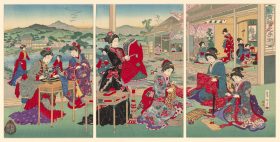Two jam-packed days of free events open the National Gallery of Australia’s fourth National Indigenous Art Triennial on Saturday 26 and Sunday 27 March.
Extending upon the theme Ceremony, a breadth of engaging family-friendly events kicks off at the NGA entrance at 10am Saturday with a Welcome to Country smoking ceremony held by Ngambri and Ngunnawal custodians and artists Dr Matilda House and Paul Girrawah House.
Delve into the Triennial until 7pm Saturday as the Gallery extends its opening hours to stage activities, performances, live music, workshops and panel discussions.
‘Ceremony is testament that our culture has survived – not only over the many thousands of years but, particularly, the last couple of hundred years – because of its capacity for innovation and adaptability,’ said Senior Curator-at-Large Hetti Perkins, an Arrernte and Kalkadoon woman.
The 4th National Indigenous Art Triennial: Ceremony features more than 35 artists from across Australia, including those from two major art centres, Yarrenyty Arltere and Tangentyere (Larapinta Valley Town Camp, Alice Springs).
‘Like a formula that has an “active ingredient” or “radical agent”, each work in Ceremony will have a performative element or purpose. The idea of “active” is central: works that are active; works that are activist; works that activate,’ Perkins said.
What’s on at the opening weekend?
Highlights include the premiere of photographic storyteller Hayley Millar Baker’s first film, NYCTINASTY, with an introduction by the artist at 11am, followed by discussions with Ceremony artists about the moving image at 1pm.
For those who can’t make it to Canberra, a panel at 3:30pm featuring artists Joel Bray, SJ Norman and Darrell Sibosado on performance will be livestreamed, with captioning and Auslan interpretation to ensure accessibility for all.
On Sunday, the 11am panel discussion Working with Country features Nicole Foreshew, Robert Andrew and Paul Girrawah House and Dr Matilda House, while Joel Spring, Penny Evans and James Tylor headline the discussion on Reading Country at 1pm (live-streamed with captions and Auslan interpretation).
The opening weekend also features ceremonies of a more contemporary nature thanks to a line-up of local First Nations musicians and sound artists playing live across both days of the weekend.
If you’re seeking more hands-on activities, register for workshops with Yarrenyty Arltere Artists at 11.30am on Saturday with audio description for Blind and low vision participants and Sunday with Auslan interpretation for Deaf participants. On Saturday afternoon, Andy Snelgar shares carving practices. On Sunday, be immersed in a bush healing workshop with Nicole Foreshew from 2.30pm.
Accompanying the Ceremony exhibition is Wiradjuri artist SJ Norman’s Bone Library activation, drawing upon the living essence of First Nations languages through a live inscription.
Roving performances by Joel Bray will activate the gallery from 2pm on both days. The Wiradjuri dancer will also present his first film work, commissioned for Ceremony, as part of the Triennial.
The weekend concludes with a tree-scarring ceremony by Dr Matilda House and Paul Girrawah House in the NGA’s lakeside Sculpture Garden from 3.30pm, a cultural practice distinctive to southeastern Aboriginal communities.
For Perkins, ceremony transcends the boundaries of past or future. ‘In each ceremonial action, artists make an individual mark in this history. Ceremony is the nexus of Country, culture and community, and the 4th National Indigenous Art Triennial: Ceremony is another stitch in a timeless heritage,’ Perkins concluded.
The 4th National Indigenous Art Triennial: Ceremony runs from 26 March – 31 July 2022. All opening weekend events are free with gallery entry; registrations are required for programs with capacity limitations.





